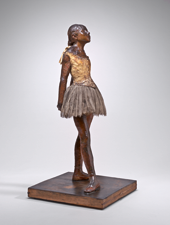Little Dancer Aged Fourteen
Technical Notes: Internal Construction
Technical Notes: Exterior Construction
Study in the Nude of Little Dancer Aged Fourteen (Nude Little Dancer)
Fourth Position Front, on the Left Leg
Introduction to Entry
Degas’s most famous sculpture, Little Dancer Aged Fourteen is one of the stars of early modern art and perhaps the single work that, for many, represents his art in general. As the only sculpture known to have been exhibited in his lifetime, in 1881, it provides scholars with the one firm benchmark by which to study his three-dimensional work and the critics’ response to it.
The title given here is a translation of the one published in the impressionist catalogues, Petite danseuse de quatorze ans. Until recently, however, it was most often called by a posthumous name, the Dressed Dancer or Big Dressed Dancer (Danseuse habillée or Grande danseuse habillée), that first appeared, handwritten, in the 1921 Hébrard exhibition catalogue (apparently the wax was a late addition). Though replaced there with the original title, variations on Dressed or Big Dressed Dancer became standard even in Knoedler’s 1955 exhibition catalogue (Ballet Dancer, Dressed).[1] Rewald’s 1944 catalogue raisonné perpetuated both: Ballet Dancer, Dressed as its English title but Petite danseuse de quatorze ans in French.[2]
The posthumous Big Dressed Dancer title is important because it asserts this figure’s relationship to (in its differences from) the smaller nude variant Study in the Nude of Little Dancer Aged Fourteen.
Notes
1. M. Knoedler and Company, Edgar Degas, 1834–1917: Original Wax Sculptures, exh. cat. (New York, 1955), cat. 20. For examples of its use for the bronzes, see Galerie Georges Petit, Exposition Degas au profit de la ligue franco-anglo-américaine contre le cancer, exh. cat. (Paris, 1924), cat. 290; Musée de l'Orangerie, Degas: Portraitiste, sculpteur, exh. cat. (Paris, 1931), cat. 73. Perhaps coincidentally, the title is an abbreviated form of its description in the posthumous inventory.
2. John Rewald, Degas, Works in Sculpture: A Complete Catalogue, trans. John Coleman and Noel Moulton (New York, 1944), cat. XX.
